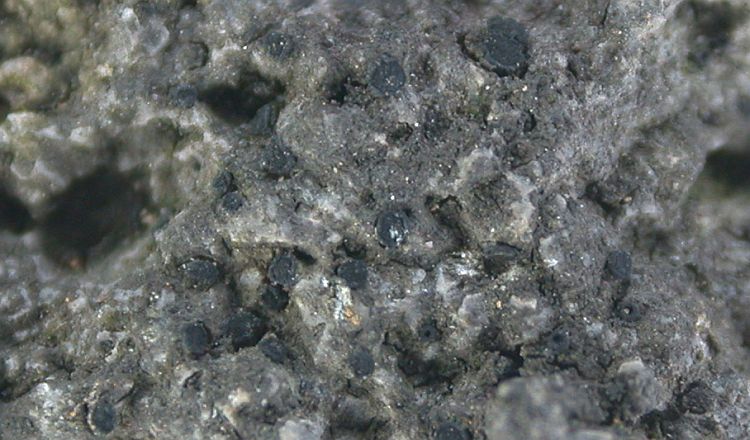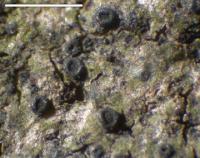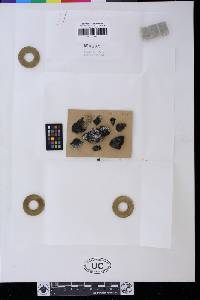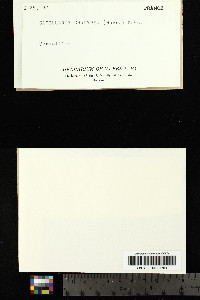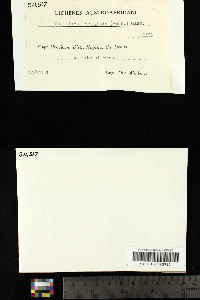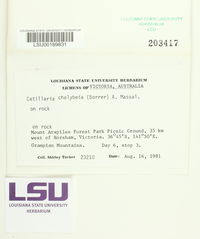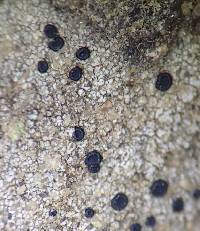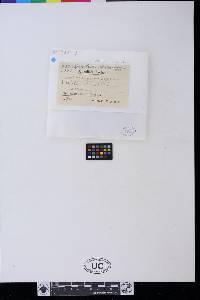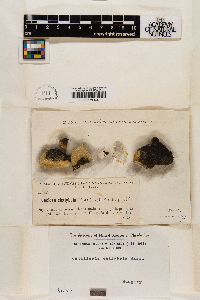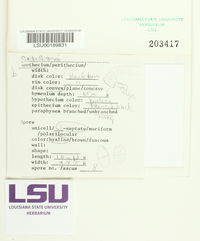
Consortium of Lichen Herbaria
- building a Global Consortium of Bryophytes and Lichens as keystones of cryptobiotic communities -
- Home
- Search
- Images
- Species Checklists
- US States: O-Z >
- US National Parks
- Central America
- South America
- US National Parks
- Southern Subpolar Region
|
|
|
|
Family: Catillariaceae
[Biatorina chalybeia (Borrer) Mudd, moreBiatorina chalybeia subsp. chalybeia (Borrer) Mudd, Biatorina melastigma (Taylor) Mudd, Buellia chalybeia (Borrer) Bagl., Catillaria chalybeia var. chalybeia (Borrer) A. Massal., Lecidea chalybeia Borrer, Lecidea melastigma Taylor, Microlecia chalybeia (Borrer) M. Choisy, Microlecia lenticularis var. chalybeia (Borrer) M. Choisy, Patellaria chalybeia (Borrer) Müll. Arg.] |
Nash, T.H., Ryan, B.D., Gries, C., Bungartz, F., (eds.) 2007. Lichen Flora of the Greater Sonoran Desert Region. Vol 3. Thallus: crustose, effuse or delimited, sometimes mosaic forming; 80-200 µm thick, continuous to rimose-areolate, squamulose-areolate, or minutely areolate-verrucose, sometimes only developing in places or disappearing, thin, 1-3(-6) cm in diam.; prothallus: mostly indistinct or absent, rarely forming a dark brown to black delimiting border, occasionally even fibrous and well developed areoles: 0.1-0.4(-1) mm in diam., when squamulose occasionally widely separated and the margins ±lifted up surface: beige or dirty white to more usually dark olivaceous to blackish gray, ashy black, dark gray-brown or brownish black, smooth to irregularly uneven or warty, dull or slightly oily-glossy, often appearing dark through epiphytic cyanobacteria (beige to dark brown when wet), esorediate cortex: phenocortex, (5-)10-35 µm thick; epinecral layer: 5-10 µm thick photobiont: Myrmecia reticulata, the cells 7-17 µm in diam., mostly with well-developed haustoria; algal layer: 50-100 µm thick medulla: mostly very thin, endolithic, rarely up to 50 µm thick Apothecia: mostly numerous, (0.15-)0.2-0.5(-1) mm in diam., scattered to dense, or in crowded clusters of 2-5, then slightly mutually deformed, broadly adnate, becoming sessile with constricted base disc: dark brown to black (when wet sometimes pale to dark brown with darker margin), epruinose, dull to velvety- or oily-shiny, slightly scabrid, when young cup-shaped, flat to slightly convex, later becoming irregularly convex, when very old strongly convex, very rarely forming an umbo; margin: distinct, slightly raised, and swollen, especially when young, later thinner and becoming crowded back, occasionally somewhat crenate, greenish black or sometimes paler than disc, usually persistent exciple: chalybeia-type, carbonaceous black, at least in a broad marginal region, paler inside and concolorous with hypothecium, or entirely carbonaceous; at the edge of the hymenium mostly diffuse blue-green epihymenium: dark brown to (greenish-)black, 8-15(-20) µm thick hymenium: hyaline, often at least in the lower part and at the edge of the exciple becoming pale to bright blue-green, I+ blue then dirty blue to violet or becoming wine red (gelatinous coat of asci reddish, hymenial gelatin blue-violet to red; ascus tips blue), (40-)45-60(-70) µm tall; paraphyses: lenticularis-type, 1.5-2 µm wide, simple or rarely forked, lax; apices capitate to 6 µm wide, with dark brown to black cap; hypothecium: pale to bright red-brown or dark brown, in upper part mostly blue-green, 60-130(-150) µm thick asci: subcylindrical, 30-50 x 10-15 µm, the wall 1-1.5 µm thick; Catillaria-type [Lecanora-type according to the description in Kilias, but Bacidia-type sensu Hafellner according to his fig. 23!], 8-spored, the spores biseriate ascospores: hyaline, 1-septate, oblong-ovoid to oblong-ellipsoid, the ends rounded to pointed, (7-)9.6-12.2(-15) x (2.5-)3.1-4.1(-5) µm Pycnidia: immersed, rounded-ellipsoid, 50 x 80 µm or 100 µm in diam., the wall dark green, the outer cells with dark brown caps conidia: ovoid- to short-bacilliform, constricted as in bayonet-type, 1.8-3.5 x 0.5-0.8(-1.2) µm Spot tests: thallus K-, C-, KC-, P-; green pigment in epihymenium, hymenium and exciple K- (or green intensifying), N+ purple-red; hypothecium K- Secondary metabolites: none detected by TLC. Substrate and ecology: on wide range of acidic, or more usually, slightly basic or nutrient-enriched rocks, preferring siliceous rocks (gneiss, granite, sandstone, porphyrite, quartz), especially on marine and lake shores, rare on highly calcareous substrates; occasionally on dust-impregnated timberwork and tree trunks World distribution: widely occurring in Europe, northern Africa, South America, and northern and western North America Sonoran distribution: southern Arizona, southern California, and Baja California. Notes: Catillaria chalybeia is a very variable species, especially in thallus appearance, but is distinguished among saxicolous species in the Sonoran region by having the exciple carbonaceous black at least in a broad marginal region. Material with a hyaline hymenium but otherwise similar to the type, was described as var. chloropoliza. The species has been confirmed from southern California and Baja California by the senior author, and from Arizona by the second author. |
|
|
|
Powered by Symbiota

